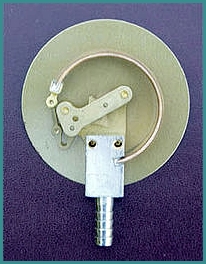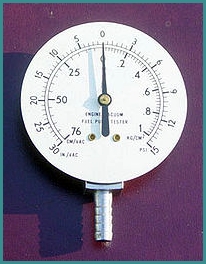How a Pressure Gauge is Manufactured – Como é Fabricado um Manômetro Tipo Bourdon
How a Pressure Gauge is Manufactured – Como é Fabricado um Manômetro Tipo Bourdon
nov 24 Number of View :7525
Mechanical vacuum gauges
These mechanical vacuum gauges vacuum gauges are simple, robust and cheap, which explains its wide application in industrial processes.
Bourdon Type
These are the mechanical vacuum gauges simpler and cheaper. The Bourdon type vacuum gauges do not measure absolute pressure, but the relative pressure to the local barometric pressure. They are usually round and have a scale of 0 to 30 “Hg or 0 to 760 mm Hg. The heart of this type of vacuum gauge is the Bourdon tube, invented by French engineer Eugene Bourdon, in 1849.
The metal pipe section is elliptical, has thin walls and is generally curved in an arc shape, resembling the letter “C”. The tube is closed at one end and open on the opposite side. The outside of the tube is subject to atmospheric pressure. With the vacuum gauge connected to a system that is under vacuum, the inner tube is evacuated and atmospheric pressure will cause it to curve inward. Increased pressure will produce an opposite effect, with the tube slightly opening to indicate an increase in pressure.
The response to this pressure change is not linear, but with proper design and by adjusting the setting of the pointer, the relationship between hand movement and pressure change can come very close to linear. As a general rule, these vacuum gauges are not very accurate, however there are already some special construction instruments that have excellent accuracy and also provide readings in absolute units.
Common problems with Bourdon type vacuum gauges are: – accumulation of materials from the process within the Bourdon tube; – break or damage of the pointer setting mechanism , due to breakage or vibration of the instrument – conversion error to absolute units, when the atmospheric pressure is taken wrongly.
 Vacuômetros mecânicos Estes vacuômetros são os mais simples, robustos e baratos, o que justifica sua grande aplicação nos processos industriais.
Vacuômetros mecânicos Estes vacuômetros são os mais simples, robustos e baratos, o que justifica sua grande aplicação nos processos industriais.
Tipo Bourdon
Estes são os vacuômetros mecânicos mais simples e baratos. Os vacuômetros tipo Bourdon não medem pressão absoluta e sim a pressão relativa à pressão barométrica local, são normalmente redondos e possuem escala de 0 a 30″ de Hg ou 0 a 760 mm Hg. O coração deste tipo de vacuômetro é o tubo Bourdon, inventado pelo engenheiro frances Eugene Bourdon, em 1849 .
O tubo de metal tem secção eliptica, paredes finas e geralmente é curvo em forma de arco, lembrando a letra “C”. O tubo é fechado de um lado e aberto do lado oposto. O lado externo ao tubo está sujeito à pressão atmosférica. Com o vacuômetro conectado a um sistema que está sob vácuo, o interior do tubo será evacuado e a pressão ambiente fará com que ele se curve para dentro. O aumento de pressão produzirá um efeito contrário, com o tubo se abrindo levemente para indicar um aumento de pressão.
A resposta a esta mudança de pressão não é linear, mas com um projeto adequado e com o ajuste da fixação do ponteiro, a relação entre o movimento do ponteiro e a alteração de pressão pode se aproximar em muito da linear. Como regra geral, estes vacuômetros não são muito precisos, entretanto já existem alguns instrumentos de construção especial que apresentam excelente precisão e também propiciam leituras em unidades absolutas.
Os problemas comuns com vacuômetros tipo Bourdon são: – acúmulo de materiais vindos do processo dentro do tubo Bourdon; – quebra ou danificação do mecanismo de fixação do ponteiro, devido a quebra ou vibração do instrumento; – erro de conversão para unidades absolutas, quando a pressão atmosférica for tomada erroneamente.



